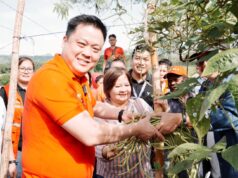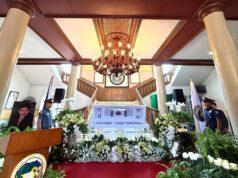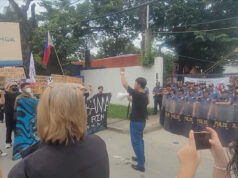CLARK FREEPORT – As the nation commemorated Bonifacio Day last Nov. 29, the Philippine Air Force (PAF) got another shot in its military arm as four more brand new SF-260 basic trainer aircraft were turned over to it in simple rites at the Haribon Hangar of the 410th Maintenance Wing here.
PAF spokesperson Lt. Col. Ernesto Okol told Punto the four aircraft comprised the second batch of a total of 18 such airplanes costing a total of P622.59-million manufactured by Aerotech Industries Philippines, Inc., a partner of Italy-based aircraft manufacturer Alenia Aermacchi, for the PAF.
“The acquisition of the new aircraft is a modest modernization for the Philippine Air Force and a big boost for PAF’s capability to train PAF pilots,” Okol said.
The first batch of four similar aircraft was turned over to the PAF also in the same venue earlier November this year.
Okol said “the increase in the number of SF-260FH fleet and positive changes made in improving the training curriculum for pilot training will further enhance and develop pilots professionally.”
“This will also keep them up to date with the changing times and advancements of technology in accordance with the Philippine Air Force’s thrusts in contributing to peace and development of our country,” he added.
Dubbed as the perfect screener, the SF-260 FH is used in other countries to select potential candidates to progress to high performance aircraft, he noted.
Okol noted that in the Philippines, “the current Pilot Training System of the PAF is designed to satisfy our requirements in the so-called T-41D training level. Aviation students advance to the SF-260FH — where training students are taught various types of maneuvers and techniques of flying involving greater speed and attention to details while subjected to higher level of G-force, after satisfying the requirements in the T-41D.”
“During the primary phase, or the flight training in the T-41, students are introduced to the fundamentals of flying and handling an air craft: how to take off and land safely, perform contact proficiency, develop techniques in basic and advance instrument flying, fly dual formations, and navigate flights to other aerodromes,” he said.
Okol said that those who finish the entire course become “quality and competent pilots who are expected to operate the air assets of the Air Force and perform various missions related to rescue operations, security, and other support functions to peace and national development.”
Capt. Archimedes Alde, commander of the 102nd basic pilot training squadron, said the aircraft are to be used at Fernando Air Base in Lipa City in Batangas for the training of 150 student pilots of the PAF there.
PAF spokesperson Lt. Col. Ernesto Okol told Punto the four aircraft comprised the second batch of a total of 18 such airplanes costing a total of P622.59-million manufactured by Aerotech Industries Philippines, Inc., a partner of Italy-based aircraft manufacturer Alenia Aermacchi, for the PAF.
“The acquisition of the new aircraft is a modest modernization for the Philippine Air Force and a big boost for PAF’s capability to train PAF pilots,” Okol said.
The first batch of four similar aircraft was turned over to the PAF also in the same venue earlier November this year.
Okol said “the increase in the number of SF-260FH fleet and positive changes made in improving the training curriculum for pilot training will further enhance and develop pilots professionally.”
“This will also keep them up to date with the changing times and advancements of technology in accordance with the Philippine Air Force’s thrusts in contributing to peace and development of our country,” he added.
Dubbed as the perfect screener, the SF-260 FH is used in other countries to select potential candidates to progress to high performance aircraft, he noted.
Okol noted that in the Philippines, “the current Pilot Training System of the PAF is designed to satisfy our requirements in the so-called T-41D training level. Aviation students advance to the SF-260FH — where training students are taught various types of maneuvers and techniques of flying involving greater speed and attention to details while subjected to higher level of G-force, after satisfying the requirements in the T-41D.”
“During the primary phase, or the flight training in the T-41, students are introduced to the fundamentals of flying and handling an air craft: how to take off and land safely, perform contact proficiency, develop techniques in basic and advance instrument flying, fly dual formations, and navigate flights to other aerodromes,” he said.
Okol said that those who finish the entire course become “quality and competent pilots who are expected to operate the air assets of the Air Force and perform various missions related to rescue operations, security, and other support functions to peace and national development.”
Capt. Archimedes Alde, commander of the 102nd basic pilot training squadron, said the aircraft are to be used at Fernando Air Base in Lipa City in Batangas for the training of 150 student pilots of the PAF there.



